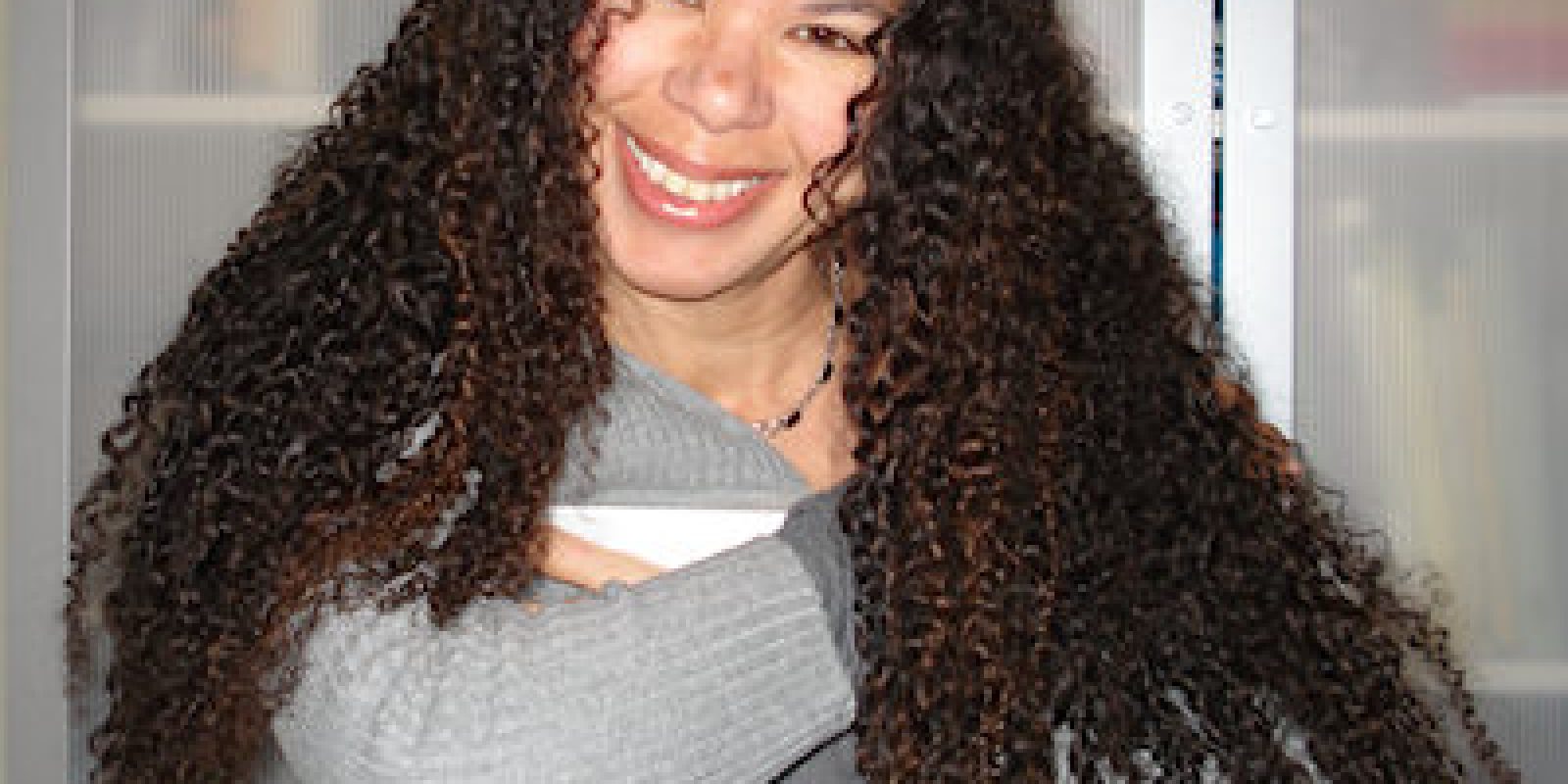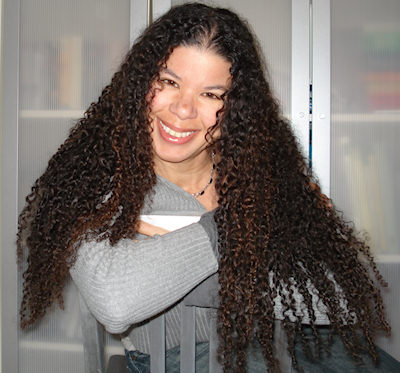 Mireille pointed out something profound to me: I’d mentioned to her that it’s so hard to imagine now how much I used to hate my hair and feel cursed by it—when all along it was how I’d been taught to care for it that had made it so scary.
Mireille pointed out something profound to me: I’d mentioned to her that it’s so hard to imagine now how much I used to hate my hair and feel cursed by it—when all along it was how I’d been taught to care for it that had made it so scary.
I adore that she brought this to my attention. I try to convey this indirectly when I talk about my hair, but I loved that she pointed this tendency out to me. It got me to thinking about my soap opera of a hair history: why was it that I grew up feeling my hair was inherently wrong? So wrong that I brutalized it with chemicals and felt I had been cursed by it. I look at my hair now and I can’t imagine mistreating it the way I once did.
In the beginning, I didn’t even know I had curly hair. My hair had been straightened ever since I could remember. Every night my grandmother on my mom’s side (who was black) would spend an hour on it. She’d divide it in sections, comb each section, smooth on a dab of French Perm hairdressing onto the section, and twist it up in about two-dozen little buns. I used to stare at girls with very long straight hair, wondering how they got their hair longer than mine. Since already mine was so labor intensive, I couldn’t imagine what else they were doing to get theirs longer. Even with all the work being put into mine every night, it struggled to reach much past my shoulders.
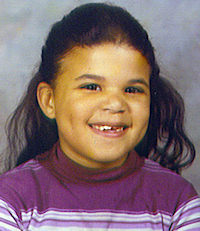
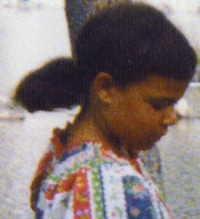
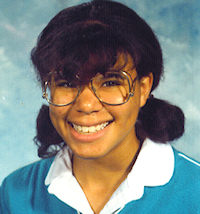
1st Grade Antenna tail straight ponytail
Everything changed with my hair after I accidentally got the Curl: When I was about eleven, my mom took me to have my hair professionally relaxed instead of my grandmother doing it. Maybe it was in hopes that a professional would be able to make it grow longer. After arriving, I was taken to a back room where they showed me a book of pictures and asked me which one I liked. Not really thinking about it, I picked the drawing of the prettiest girl in the book, with curly hair blowing in the wind.
Before I realized it, they cut off my hair in the front, and then put in a Jheri curl—on top of my already straightened hair. So I had a Jheri Curl mullet, with straight longer hair in the back and greasy short curls in the front. When I was led back out to the waiting room, my mom stared at me in shock. The woman explained that my hair would look “even better” as it grew out: wavy hair with pretty ringlets on the ends. She made it sound really good.
Once home, it was decided the rest of my hair was too damaged, and the mullet part was cut off, leaving me with just the greasy Jheri curl. I spent the summer with my dad (who is white) who refused to let me put the Jheri concoction on my hair. I had no idea what to do with it then, so I combed it every morning, and patted it into as round a shape as possible.
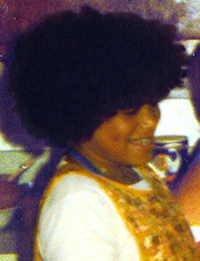
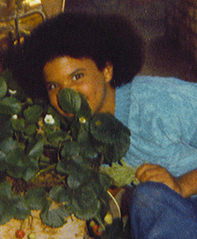
Dish fro – Strawberry fro
By the end of the summer I had a giant mushroom head, but no waves with ringlets on the ends. All summer wavy-haired girls at summer camp who could swim and then run a comb through their hair surrounded me, and it seemed so simple and easy for them. But for some reason, I couldn’t do the same thing with mine. I had no idea why that was, but I felt like something must be wrong with me (again, having no idea that different people have different types of hair, and curls just need different treatment than straighter hair).
All summer I had waited for those ringlets at the ends of my wavy hair to appear. All summer I waited while my mushroom head got bigger and bigger. And it began to feel like something must be wrong with my hair. I mean, the hairdresser said I would have ringlets at the end of my wavy hair, and hairdressers are the authorities on hair, so it must be that my hair was at fault.
When I returned to my mom’s at the end of the summer, my afro was quickly relaxed down to cake-frosting texture. From that summer I learned that if left to its own devices, my hair turned into clown-wig hair (again, not realizing it was the Jheri curl chemicals on top of a straightener in addition to brushing it dry every day all summer that made it look the way it did, not my poor hair itself).
Literally “scared straight”, I worked hard to keep the relaxer in my hair. When I went to live with my dad, I was left to figure out how to apply the chemicals on my own at 12.
 I tell you, I never got the hang of it. I always managed to do something wrong, leaving the relaxer on a minute too long or too short (so my hair got too straight or still curled up), or not getting to all my hair within the correct time frame (so sections of my hair were straight and some were curly). I walked around for weeks after applying the relaxer with second-degree burns over my head and behind my ears. My hair crunched when I touched it, and fell apart and drizzled down over my shoulders. When I wore a white tee shirt, it quickly became covered in sad little hair bits.
I tell you, I never got the hang of it. I always managed to do something wrong, leaving the relaxer on a minute too long or too short (so my hair got too straight or still curled up), or not getting to all my hair within the correct time frame (so sections of my hair were straight and some were curly). I walked around for weeks after applying the relaxer with second-degree burns over my head and behind my ears. My hair crunched when I touched it, and fell apart and drizzled down over my shoulders. When I wore a white tee shirt, it quickly became covered in sad little hair bits.
Combing my hair after washing it filled me with dread. I didn’t know about using conditioners at all at that time, so I’d shampoo, rinse, and spend hours trying to yank a comb through the mess on my head. I tried to set it in rollers but they would all slip out by morning, leaving me with a damp nest. And all the while, I was the only one on that side of the family with hair like mine. The adults around me really had no idea how to help me (I wish I’d had Mireille’s book Going Natural back then!).
Throughout high school, I spent the entire time experimenting. I finally began using conditioners and deep conditioners before rinsing out my hair, but knew nothing about ingredients to avoid, so ended up having an amazing case of sticky buildup. I bought lots of hairdressings and hair lotions and miracle grow products, and hoped that would stop my poor hair from breaking off. It only made my broken hair greasy before breaking off.
I tried texturizers, locs, extensions, braids, and a combination of all of the above at once, and dyed my hair everything from bright red to blond. I even shaved off one side of my hair down to half an inch. When one thing didn’t work I’d hack my hair off with kitchen scissors and try something else. Once, when I was 18, I dissolved my hair with a relaxer and watched it go down the drain. That was when I began wearing weaves.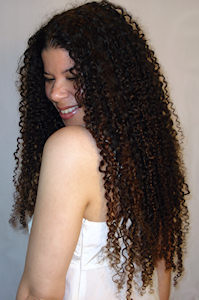
As my twenties were ending, I decided that I’d tried everything else except learning to take care of my own natural hair. I grew it out for a year and a half before I was ready to cut off the damaged hair. Growing it out wasn’t easy to do. My hair drew up and matted where my smooth-and-curly new growth met my crunchy-and-damaged chemical hair. It took me three hours to comb my hair and set it in about twenty-two strand twists every week.
But it all became worth it when I saw what my real hair looked like for the first time. Out of curiosity, I lifted the chemical hair up from behind my ear to check out my new growth. And saw my real hair for the first time in my life: confident and glossy curls, as shiny as obsidian; and it was beautiful. From then on I was hooked. I cut off all the chemical stuff, and began experimenting with how to make my real hair happy.
Now, nearly 12 years later, my hair reaches my hips when wet. I finally have the long hair I’d always dreamed of. And my hair is now as long—if not longer—than the hair I used to look at longingly as a child on other people. I now get compliments from the very people whose straight hair I was once so jealous of. They often tell me that they wished they had curls like mine.
I now know that it isn’t some flaw built into our curly hair that keeps it from growing (which is what many books on hair care would say about African-textured hair), as if it is our fate that by having curls, we can’t also have length. I’ve discovered that it was actually everything I’d been taught on how to care for my hair that damaged it, and not a flaw in my hair itself. Curly hair is fragile, much like the finest silk. And just like such silk, you wouldn’t treat it roughly, or like a common fabric such as denim—and it’s the same with our hair. Curls are special, and they need to be treated as such. I now consider my hair, the very hair I once felt cursed by, to be an incredible gift that I am grateful to have every single day. I wish there were some way I could go back and tell the girl I once was that those curls are actually a joy to have—if only she could learn how to treat them like the treasure that they are.
More about Teri at her website: http://www.tightlycurly.com/
 |
| To support your natural journey check our selection of Natural Hair Products for Black Women |

